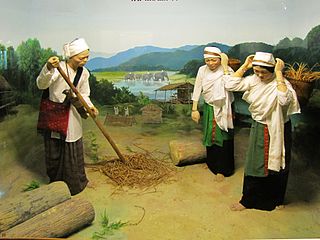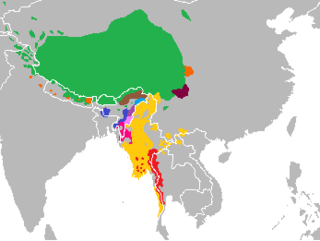
The Jingpo people are an ethnic group who are the largest subgroup of the Kachin peoples. The greater name for all the Kachin peoples in their own Jingpo language is the Jinghpaw. Other endonyms include Zaiwa, Lechi, Lisu, Maru, Hkahku,
The Indian state of Arunachal Pradesh has a total population of roughly 1.4 million on an area of 84,000 km2, amounting to a population density of about 17 pop./km2. The "indigenous groups" account for about two thirds of population, while immigrants, mostly of Bengali/Hindi belt origin, account for the remaining third.
Tshangla is a Sino-Tibetan language of the Bodish branch closely related to the Tibetic languages. Tshangla is primarily spoken in Eastern Bhutan and acts as a lingua franca in the region; it is also spoken in the adjoining Tawang tract in the Indian state of Arunachal Pradesh and the Pemako region of Tibet. Tshangla is the principal pre-Tibetan language of Bhutan.

The Khamti language is a Southwestern Tai language spoken in Myanmar and India by the Khamti people. It is closely related to, and sometimes considered a dialect of, Shan.

The People of Assam inhabit a multi-ethnic, multi-linguistic and multi-religious society. They speak languages that belong to four main language groups: Tibeto-Burman, Indo-Aryan, Tai-Kadai, and Austroasiatic. The large number of ethnic and linguistic groups, the population composition, and the peopling process in the state has led to it being called an "India in miniature".
Jingpo or Kachin is a Tibeto-Burman language of the Sal branch spoken primarily in Kachin State, Myanmar; Northeast India; and Yunnan, China. The Jingpo peoples, a confederation of several ethnic groups who live in the Kachin Hills, are the primary speakers of Jingpo language, numbering approximately 1,000,000 speakers. The term "Kachin language" may refer to the Jingpo language or any of the other languages spoken by the Jingpo peoples, such as Lisu, Lashi, Rawang, Zaiwa, Lhao Vo, and Achang. These languages are from distinct branches of the highest level of the Tibeto-Burman family.
The Sal languages, also known as the Brahmaputran languages, are a branch of Tibeto-Burman languages spoken in northeast India, as well as parts of Bangladesh, Myanmar (Burma), and China.
The Jingpho-Luish, Jingpho-Asakian, Kachin–Luic, or Kachinic languages are a group of Sino-Tibetan languages belonging the Sal branch. They are spoken in northeastern India, Bangladesh and Myanmar, and consist of the Jingpho language and the Luish languages Sak, Kadu, Ganan, Andro, Sengmai, and Chairel. Ethnologue and Glottolog include the extinct or nearly extinct Taman language in the Jingpo branch, but Huziwara (2016) considers it to be unclassified within Tibeto-Burman.
The Nung or Nungish languages are a poorly described family of uncertain affiliation within the Sino-Tibetan languages spoken in Yunnan, China and Burma. They include:

The Tibeto-Burman languages are the non-Sinitic members of the Sino-Tibetan language family, over 400 of which are spoken throughout the Southeast Asian Massif ("Zomia") as well as parts of East Asia and South Asia. Around 60 million people speak Tibeto-Burman languages. The name derives from the most widely spoken of these languages, Burmese and the Tibetic languages, which also have extensive literary traditions, dating from the 12th and 7th centuries respectively. Most of the other languages are spoken by much smaller communities, and many of them have not been described in detail.
Kadu or Kado is a Sino-Tibetan language of the Sal branch spoken in Sagaing Region, Myanmar by the Kadu people. Dialects are Settaw, Mawkhwin, and Mawteik [extinct], with 30,000 speakers total. Kadu is considered an endangered language, and is closely related to the Ganan and Sak languages.
The Puroik language is a possible language isolate spoken by the Puroik people of Arunachal Pradesh in India and of Lhünzê County, Tibet, in China.
Zahkring is a language of Arunachal Pradesh and 3 villages in Tibet.

Tangsa, also known as Tase and Tase Naga, is a Sino-Tibetan language or language cluster spoken by the Tangsa people of Burma and north-eastern India. Some varieties, such as Shangge (Shanke), are likely distinct languages. There are about 60,000 speakers in Burma and 40,000 speakers in India. The dialects of Tangsa have disparate levels of lexical similarity, ranging from 35%–97%.
Rawang, also known as Krangku, Kiutze (Qiuze), and Ch’opa, is a Sino-Tibetan language of India and Burma. Rawang has a high degree of internal diversity, and some varieties are not mutually intelligible. Most, however, understand Mutwang (Matwang), the standard dialect, and basis of written Rawang.

Nyishi (Kamle) or Sarak is a Tani language of India. It is spoken in Arunachal Pradesh by an estimated 9,000 people of the Nyishi tribe. It appears to be a dialect of the Nishi language.

Wancho (वांचो) is a Konyak language of north-eastern India. Wancho is spoken in 36 villages of southeastern Longding district, Tirap district, Arunachal Pradesh, as well as in Assam and Nagaland (Ethnologue). Alternate names include Banpara Naga, Joboka, Jokoba.

Tarao, Taraotrong or Tarau is an unclassified Tibeto-Burman language of India. It is marginally (70%) intelligible with Chothe. The speakers of this language use Meitei language as their second language (L2) according to the Ethnologue.
Central Tibeto-Burman or Central Trans-Himalayan is a proposed branch of the Sino-Tibetan language family proposed by Scott DeLancey (2015) on the basis of shared morphological evidence.
Ganan is a Sino-Tibetan language of northwestern Myanmar, spoken in Sagaing Region. It belongs to the Luish branch, and is most closely related to the Kadu language of Myanmar, with which it shares 84 to 89% lexical similarity. The Ganan dialects share 95 to 99% lexical similarity.









